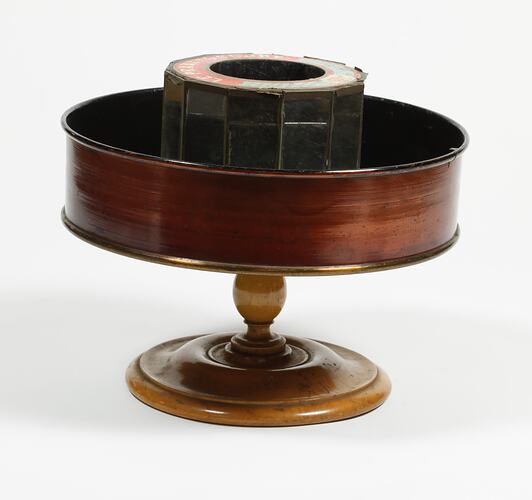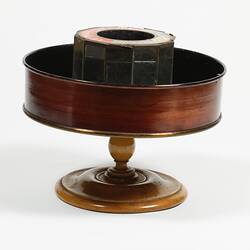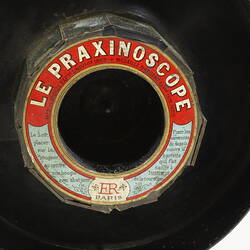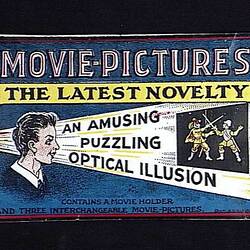Summary
The praxinoscope, invented by Charles-Emile Reynaud in 1876 was part of a range of popular philosophical or optical toys created in the 19th century. Like the praxinoscope, most attempted to create the illusion of movement using a series of static images.
In shape the Praxinoscope resembles a shallow cylinder with a concave base. Around the inner wall is a paper strip, which is changeable, featuring a series of twelve cartoons of a girl in different stages of dancing with birds. In the centre a second cylinder is situated, with twelve mirrors fixed to the outer walls, one corresponding to each image. To create the animation the outer drum is spun, the mirrors reflecting the passing images and giving the effect of fluid movement. There was often a lighting fixture at the top of this central cylinder to illuminate the images; this is missing from this apparatus.
This praxinoscope is part of the Francis Collection of pre-cinematic apparatus and ephemera, acquired by the Australian and Victorian Governments in 1975. David Francis was the curator of the National Film and Sound Archive of the British Film Institute as well as being a co-founder of the Museum of the Moving Image in London, which was operational between 1988 and 1999.
Physical Description
Metal drum with an inner and outer cylinder. The inner cylinder has 12 mirrors facing the outer cylinder, where the animation strip would be placed. A hole in the centre of the inner cylinder shows the placement for the missing candleholder and candle. The maker's logo and instruction label are placed on top of the inner cylinder. A female socket centre bottom shows the placement for the base/stand.
More Information
-
Collection Names
-
Collecting Areas
-
Acquisition Information
Loan & Subsequent Donation from Australian Film Institute (AFI), Mr David Francis, by Nov 1990
-
Inventor
Charles-Emile Reynaud, 58 Rue Rodier, Paris, France, 1876-1918
-
Collector
Mr David Francis, London, Middlesex, England, Great Britain, 1990
-
Inscriptions
Label: At top: 'LE PRAXINOSCOPE / MED DE BRONZE EXPon UNIVelle 1889 / MEDAILLE D'ARGENT EXPon 1879 PARIS' At Left: 'Le Soir,/placer/sur le/bougeoir,/au centre,/une bourgie/avec abat-jour.' At Right: 'Fixer les/extremites/du dessin/contre la/barrette/qui fait/saillie a/l'interieur/de la couronne.' At Bottom: 'ER Paris'
-
Classification
-
Category
-
Discipline
-
Type of item
-
Object Measurements
85 mm (Height), 218 mm (Outside Diameter)
-
References
-
Keywords
Animation, Optical Illusion Devices, Praxinoscopes, Pre-Cinema Moving Images, Innovation & Design





